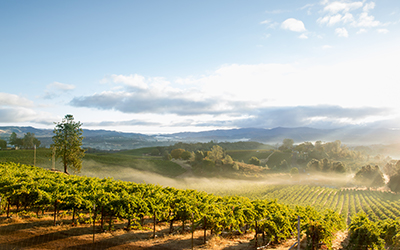As we enter the third quarter of 2021, we look back at key lessons learned from fire season last year. Hindsight is 20/20… but 2020 was more than any of us could have anticipated! While we strive for answers to resiliency around a growing worldwide pandemic, mother nature had other plans in store for us…Climate change and the ‘New Normal.’
EPIC on the Front Lines
“…Cautious optimism changed on the West Coast on August 16, when a dry lightning storm from a deteriorating tropical storm off Baja California pushed through Central California into Southern Oregon, sparking hundreds of fires. Over the following 30 days, those fires ruined hundreds of thousands of tons of grapes in California and Oregon, all but ensuring that the worldwide pandemic, as world-altering as it had been, would not be the defining attribute of the vintage.
The Glass Fire in Napa a month later added to the regional pain, creating another smoke event for the North Coast, depressing tourism and ruining or significantly damaging close to 30 wineries in Napa, along with substantial quantities of the best cabernet sauvignon grown in the world.
As we consider the possibilities and planning required for the year ahead, we stop to consider our top-level advice from the Annual State of the Wine Industry Report 2020: “The winners of tomorrow will be the wineries that…critically evaluate their organization’s capacity to react, develop solutions and execute quickly, then evaluate their success or failure to continuously improve. Those companies will take sales from those that continue to run their businesses the way they have for the past 25 years and stick with strategies that have always worked before. The winners tomorrow will be intrepid and willing to try new approaches that change the status quo.” – Silicon Valley Bank
The Health and Safety of your People is our Priority
In the event of a wildfire, your workers are exposed to smoke, ash, and chemical residue. During these times, overexposure is hard to avoid due to the nature of agricultural work.
Those who will inevitably step in during cleanup and recovery are putting themselves at risk to combat lost workdays and crop destruction.
What You’re Required to Do Once a Wildfire Occurs
When a wildfire occurs, employers are required to provide employees with certain protections and information. As you might already know, regulation §5141.1 Protection from Wildfire Smoke went into effect on July 29, 2019. This uses the local air quality index (AQI) for PM2.5 to
determine when worker protections are needed.
If employers reasonably anticipate that employees may be exposed to wildfire smoke, they must:
- Monitor the Air Quality Index (AQI) for PM2.5
- Provide training to workers, including how to determine AQI, identify health effects of wildfire smoke exposure, and how to use NIOSH-approved respirators
- Establish worker protection procedures, including a plan to reduce worker exposure to wildfire smoke
- Communicate the above workplace procedures to staff and employees
For more information, visit the State of California Department of Industrial Relations website.
EPIC Wildfire Smoke Safety Training
Our team provides safety resources and training support on wildfire smoke for both employers and employees. Contact us for an Employer Checklist that will make sure you have everything required of you covered and in place. We also have a double-sided poster and accompanying discussion guide available in both English and Spanish. These are useful, ready-made tools to help communicate the importance of wildfire smoke safety to your workforce.
We have also developed in-person training for agricultural employers and employees that provides a more comprehensive and in-depth review of the health effects of wildfire smoke exposure, worker protection procedures, and more.
Developing a Winning Strategy
Fire Preparedness
- ‘Harden’ your physical environment. Structures should be built or retrofitted with fire-resistant building materials.
- Build defensible space. Maintain at least 100 feet of defensible space around the whole perimeter of any building. Both CalFire and Napa Firewise have great resources on hardening buildings, creating defensible spaces, and general preparedness.
- Improver your Risk Profile. Time spent to improve your ‘Risk Profile’ will pay dividends in the marketing and placement (availability) of your insurance coverages going forward…as the insurance market is in upheaval, due to year-over-year catastrophes and erosion of their collective bottom line.
- Refresh your Evacuation Plan. Your business should have a detailed plan that lists the steps to be taken to protect people and property in the event of an evacuation from fire, or other threats to safety. Take the time now to meet with your employees and think through the different evacuation scenarios that could occur during the year. Make sure that all employees, including seasonal employees, are familiar with and can access the evacuation plan.
Insurance Review-Gap Analysis
Is your insurance adequate…? When is the last time your program was audited for sufficient limits, and/or gaps in coverage? As result of recurring wildfires, construction costs have increased significantly due to heightened demand for materials and labor. This can mean that your insurance limits that were adequate during normal times, have become insufficient to cover actual rebuilding costs.
EPIC can provide an assist, to review your policy terms and conditions, to ensure they are sufficient to cover potential losses after a fire or other major peril, with a critical eye towards the elimination of any ‘unconscious retention’…What, that’s not covered?
Also, keep in mind that building costs rise every year and the limits you negotiated when you bought a property may no longer be sufficient. If necessary, increase your insurance limits now.
Understand Insurance Claim Process
- Review your crop insurance policy in advance of a potential natural disaster and understand the process for making a claim.
- Some crop insurance policies require that a grower submit initial information about a potential claim shortly after the event that gives rise to the claim (in many cases, 72 hours). This requirement can be overlooked because smoke taint is often not detectable until the grapes have been made into wine, so the grower does not know there is a loss.
- File your claim “as soon as practicable”… being certain to file all paperwork necessary to preserve a claim…it is always possible to drop the claim if it turns out the fruit or other property was not actually damaged.
- Review your insurance policies to determine what supporting materials you need to file a claim. For smoke taint claims, for example, policies often require information regarding the location of the grapes, when they were affected, and for how long. Many insurance companies also require lab tests to confirm the presence of smoke taint and some will only accept results from preapproved labs.
- If the grapes are crushed, some policies require that juice from different lots be segregated and will not cover affected juice if it is mixed. Generally, it is advisable to keep track of blends, additions, and any measures taken to reduce the possible effects of smoke taint.
Review your Grape Purchase Contracts
- It is critical to understand what your grape purchase agreements say about accepting and rejecting fruit, who makes that determination, and what supporting evidence is required.
- If you have the opportunity, you should consider amending existing agreements to clarify the process — clarity benefits both parties.
- You should also be mindful of these issues when negotiating new agreements. Similar concerns apply to vineyard leases where rent is determined based on harvested tonnage.
Develop a Plan for Working Through the Smoke
Fire season is now recognized as year-round in our Mediterranean Climate…
- Develop a staffing plan that accounts for employment issues related to fires. OSHA and other regulations governing employee wellbeing apply to employees who need to work in very smoky or otherwise hazardous conditions, including obligations to provide PPE. Employees with health conditions may also be able to request accommodations.
- In addition to employment law requirements, you could encounter logistical obstacles such as power outages, evacuation orders, and road closures.
- If you have a generator, ensure it works and that you have any required permits and sufficient fuel. (If you do not have a generator, consider buying or renting one).
Also, understand the process for obtaining access permits in a mandatory evacuation zone. Although it is impossible to plan for everything, developing a staffing and operational plan now with these contingencies in mind will better position you for a smooth continuation of operations.
EPIC WINERY PRACTICE
Faced with a changing climate and a seemingly unending series of natural disasters, California wineries must contend with a complex variety of human, economic, and natural threats to their survivability and sustainability. Addressing these challenges in a nimble and creative way is why we created the EPIC Winery Practice.
EPIC’s Wine Program
Successfully managing risk by identifying and controlling potential sources of loss is the most effective way to protect your winery and reduce its insurance costs. Dedicated EPIC safety and claims consultants set us apart and are essential to this strategy.
We deliver comprehensive, cost-effective, leading-edge products and services from the world’s top insurance companies and specialty carriers. We know our business and yours, which allows us to represent you intelligently and aggressively in the marketplace.
Related Content
Programs
Wine
Successfully managing risk by identifying and controlling potential sources of loss is the most effective way ...
Products
Risk Management
Our experienced teams take an enterprise-wide approach, consulting closely with you to identify, analyze and ...
About EPIC
We are a unique and innovative retail risk management and employee benefits insurance brokerage and ...


